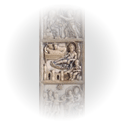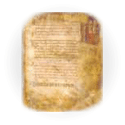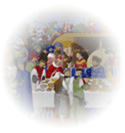Today books are made with the aid of couputer software that can lay out pages, set type, insert illustrations. In the Meddle Ages before invention of printing in 1450 by Johannes Gutenberg, books were made by hand one at the time with ink, pen, brush, paint, covered in engraved wooden, metal or ivory panels which depict scenes from Bible, New Testament or Golden Book.
 Medieval books were usually made by monks and nuns
in a workshop called scriptorium which was usually within a monastery or a convent. As the demand
for book increased, lay professionals join the work and great-rulers set up palace workshops
supervised by well-known scholars. Books were written on animal skin - either vellum, which was
fine and soft, or parchment, which was heavier and shinier. Paper did not come into common use
until early XV century. Small book required the skin of more than 150 calves, a great treasure
considering the value of one cow at the time. The skins were cleaned, stripped of hair, and
scraped to create a smooth surface that would absorb metallic inks and water based paints,
which themselves required time and experience to prepare. Many pigments particularly blues
(indigo, ultramarine) and greens had to be imported from the east and were as costly as
semiprecious stones. In early
manuscripts, bright yellow was used to suggest gold. Later manuscripts were decorated with
real gold leaf or about 100 years later gold paint. In the specialized workshops
work on a book was divided between a scribe who copied the text and one or more artists, who
did illustrations, large initials, arabesques and other decorations. More often, especially
in the early Middle Ages scribe and artist was the same person. Although most books were
produced anonymously, scribes and illustrators began to sign their book and provide a
Medieval books were usually made by monks and nuns
in a workshop called scriptorium which was usually within a monastery or a convent. As the demand
for book increased, lay professionals join the work and great-rulers set up palace workshops
supervised by well-known scholars. Books were written on animal skin - either vellum, which was
fine and soft, or parchment, which was heavier and shinier. Paper did not come into common use
until early XV century. Small book required the skin of more than 150 calves, a great treasure
considering the value of one cow at the time. The skins were cleaned, stripped of hair, and
scraped to create a smooth surface that would absorb metallic inks and water based paints,
which themselves required time and experience to prepare. Many pigments particularly blues
(indigo, ultramarine) and greens had to be imported from the east and were as costly as
semiprecious stones. In early
manuscripts, bright yellow was used to suggest gold. Later manuscripts were decorated with
real gold leaf or about 100 years later gold paint. In the specialized workshops
work on a book was divided between a scribe who copied the text and one or more artists, who
did illustrations, large initials, arabesques and other decorations. More often, especially
in the early Middle Ages scribe and artist was the same person. Although most books were
produced anonymously, scribes and illustrators began to sign their book and provide a
little background information on the page called the colophon.
 Colophon description of this page translated into English:
Colophon description of this page translated into English:
"This volume of the divine Psalms was completed in the month
of February of the fourth in diction of the year 6574 (1066) on the order of the divinely inspired
father and synkellos Michael, Abbot of the all-holy and all-blessed monastery.
Written and written in gold by the hand of Theodore the protopresbyter of the monastery and scribe
from Caesaria, whose shepherd and luminary was the glorious and brilliant Basil, who was truly great and was also so named.
All glory and power are due to Christ."
Another scribe (now anonymous) form the end of XII century went further and took the opportunity
to warn the reader
"Or reader turns the leaves gently and keep your fingers away from the letters, as the hailstorm ruins
the harvest, so does the injurious reader destroy the book and the writing."
Because of rareness and a high price of manuscripts in the Middle Ages, they were the best gift for Queens, Kings, princes, church and lay dignitaries handed during official meetings and audiences. Many manuscripts were also sent as a gift by special courier for a such occasions like marriages, coronations, birthdays, ordinations, and even funerals. They were usually commissioned in lay workshop.
 This a private devotional book, completed by 1408 or 1409, probably in Paris, "The Belles Heures,"
was the first of several sumptuous manuscripts commissioned by the duke of Berry from the
Limbourg brothers, Pol, Jean, and Herman. It is perhaps the only virtually complete and
stylistically consistent prayer book to survive from the duke's extraordinary library.
The richly illustrated text reflects the duke's personal interests. Using a luminous palette,
the artists blended an intimate Northern vision of nature with Italianate modes of figural
articulation. The keen interest in the natural world and the naturalistic means of representing it,
so striking in ninety-four full-page and fifty-four column
illuminations, foreshadow the work of Jan van Eyck and the ensuing generations of outstanding
fifteenth-century painters
in the South Netherlands.
This a private devotional book, completed by 1408 or 1409, probably in Paris, "The Belles Heures,"
was the first of several sumptuous manuscripts commissioned by the duke of Berry from the
Limbourg brothers, Pol, Jean, and Herman. It is perhaps the only virtually complete and
stylistically consistent prayer book to survive from the duke's extraordinary library.
The richly illustrated text reflects the duke's personal interests. Using a luminous palette,
the artists blended an intimate Northern vision of nature with Italianate modes of figural
articulation. The keen interest in the natural world and the naturalistic means of representing it,
so striking in ninety-four full-page and fifty-four column
illuminations, foreshadow the work of Jan van Eyck and the ensuing generations of outstanding
fifteenth-century painters
in the South Netherlands.
As well as other masterpieces, this book also has changed hands several times starting from its first owner: Jean, Duke of Berry, 1408–9; first included in his inventory (1413–d. 1416); through Yolande of Aragon, Queen of Sicily and Duchess of Anjou (purchased in 1416 from the Duke's estate–d. 1443); through Baron d'Ailly (sold 1880); through Baron Edmond de Rothschild, Paris, France (acquired 1880, his inventory no. 18); through Baron Maurice de Rothschild, Geneva, Switzerland (acquired 1936, his inventory no. 7); [Rosenberg & Stiebel, New York] to end up in the Museum of Art in New York, USA where it can be seen.